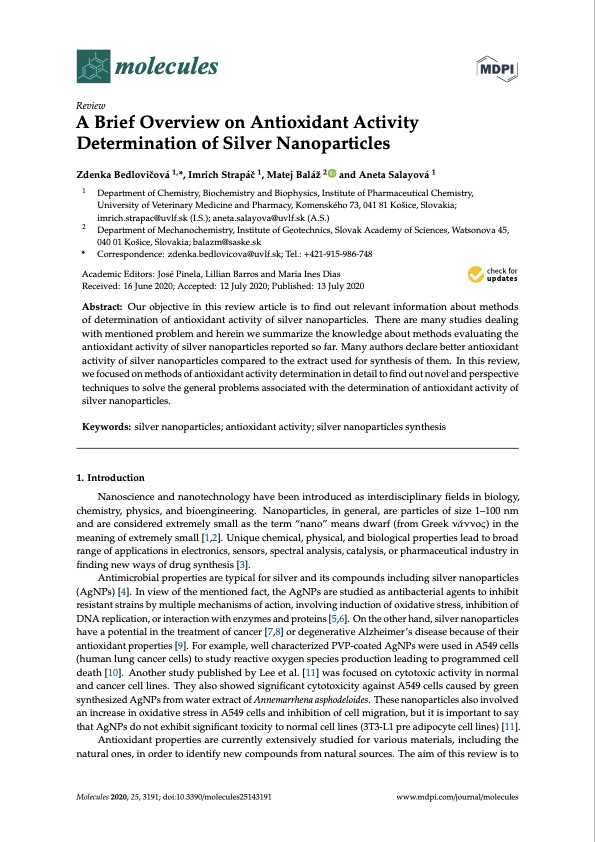
PDF Publication Title:
Text from PDF Page: 001
molecules Review A Brief Overview on Antioxidant Activity Determination of Silver Nanoparticles Zdenka Bedlovicˇová 1,*, Imrich Strapácˇ 1, Matej Baláž 2 and Aneta Salayová 1 1 Department of Chemistry, Biochemistry and Biophysics, Institute of Pharmaceutical Chemistry, University of Veterinary Medicine and Pharmacy, Komenského 73, 041 81 Košice, Slovakia; imrich.strapac@uvlf.sk (I.S.); aneta.salayova@uvlf.sk (A.S.) Department of Mechanochemistry, Institute of Geotechnics, Slovak Academy of Sciences, Watsonova 45, 040 01 Košice, Slovakia; balazm@saske.sk 2 * Correspondence: zdenka.bedlovicova@uvlf.sk; Tel.: +421-915-986-748 Academic Editors: José Pinela, Lillian Barros and Maria Ines Dias Received: 16 June 2020; Accepted: 12 July 2020; Published: 13 July 2020 Abstract: Our objective in this review article is to find out relevant information about methods of determination of antioxidant activity of silver nanoparticles. There are many studies dealing with mentioned problem and herein we summarize the knowledge about methods evaluating the antioxidant activity of silver nanoparticles reported so far. Many authors declare better antioxidant activity of silver nanoparticles compared to the extract used for synthesis of them. In this review, we focused on methods of antioxidant activity determination in detail to find out novel and perspective techniques to solve the general problems associated with the determination of antioxidant activity of silver nanoparticles. Keywords: silver nanoparticles; antioxidant activity; silver nanoparticles synthesis 1. Introduction Nanoscience and nanotechnology have been introduced as interdisciplinary fields in biology, chemistry, physics, and bioengineering. Nanoparticles, in general, are particles of size 1–100 nm and are considered extremely small as the term “nano” means dwarf (from Greek να ́ννoς) in the meaning of extremely small [1,2]. Unique chemical, physical, and biological properties lead to broad range of applications in electronics, sensors, spectral analysis, catalysis, or pharmaceutical industry in finding new ways of drug synthesis [3]. Antimicrobial properties are typical for silver and its compounds including silver nanoparticles (AgNPs) [4]. In view of the mentioned fact, the AgNPs are studied as antibacterial agents to inhibit resistant strains by multiple mechanisms of action, involving induction of oxidative stress, inhibition of DNA replication, or interaction with enzymes and proteins [5,6]. On the other hand, silver nanoparticles have a potential in the treatment of cancer [7,8] or degenerative Alzheimer’s disease because of their antioxidant properties [9]. For example, well characterized PVP-coated AgNPs were used in A549 cells (human lung cancer cells) to study reactive oxygen species production leading to programmed cell death [10]. Another study published by Lee et al. [11] was focused on cytotoxic activity in normal and cancer cell lines. They also showed significant cytotoxicity against A549 cells caused by green synthesized AgNPs from water extract of Annemarrhena asphodeloides. These nanoparticles also involved an increase in oxidative stress in A549 cells and inhibition of cell migration, but it is important to say that AgNPs do not exhibit significant toxicity to normal cell lines (3T3-L1 pre adipocyte cell lines) [11]. Antioxidant properties are currently extensively studied for various materials, including the natural ones, in order to identify new compounds from natural sources. The aim of this review is to Molecules 2020, 25, 3191; doi:10.3390/molecules25143191 www.mdpi.com/journal/moleculesPDF Image | Antioxidant Activity Determination of Silver Nanoparticles

PDF Search Title:
Antioxidant Activity Determination of Silver NanoparticlesOriginal File Name Searched:
molecules-25-03191.pdfDIY PDF Search: Google It | Yahoo | Bing
Turbine and System Plans CAD CAM: Special for this month, any plans are $10,000 for complete Cad/Cam blueprints. License is for one build. Try before you buy a production license. More Info
Waste Heat Power Technology: Organic Rankine Cycle uses waste heat to make electricity, shaft horsepower and cooling. More Info
All Turbine and System Products: Infinity Turbine ORD systems, turbine generator sets, build plans and more to use your waste heat from 30C to 100C. More Info
CO2 Phase Change Demonstrator: CO2 goes supercritical at 30 C. This is a experimental platform which you can use to demonstrate phase change with low heat. Includes integration area for small CO2 turbine, static generator, and more. This can also be used for a GTL Gas to Liquids experimental platform. More Info
Introducing the Infinity Turbine Products Infinity Turbine develops and builds systems for making power from waste heat. It also is working on innovative strategies for storing, making, and deploying energy. More Info
Need Strategy? Use our Consulting and analyst services Infinity Turbine LLC is pleased to announce its consulting and analyst services. We have worked in the renewable energy industry as a researcher, developing sales and markets, along with may inventions and innovations. More Info
Made in USA with Global Energy Millennial Web Engine These pages were made with the Global Energy Web PDF Engine using Filemaker (Claris) software.
Infinity Turbine Developing Spinning Disc Reactor SDR or Spinning Disc Reactors reduce processing time for liquid production of Silver Nanoparticles.
| CONTACT TEL: 608-238-6001 Email: greg@infinityturbine.com | RSS | AMP |